Once upon a time when I was a corporate drone, I traveled a lot on my employer’s dime. My former employer’s policy was to allow their business travelers to keep any miles they accrued, and over the years, I managed to accrue a fair amount–some of which I have used to pay for some nice trips and for some upgrades. I was down to about 30,000 miles on American Airlines when I got the notice that these miles would all go “poof” if I didn’t add some miles by the end of June. Yeah, I could have just used one of the bonus partner offers, such as a fancy restaurant and so on, but I wanted to take a nice weekend somewhere.
My office is about 15 minutes from the Fort Lauderdale/Hollywood International Airport, so I looked at nonstop flights from there. The best availability at the best times were either Dallas/Fort Worth or Chicago. Well, I don’t know anyone in Dallas or Fort Worth (other than some suppliers I worked with in my previous job, but stopping to see them would be awkward at best), and I have a ton of cousins in Chicago, so Chicago it was!

The Chicago skyline and Millennium Park as viewed from the Art Institute
I found some great flight times that got me out within a few hours of the end of my working day, and a return flight that would get me back to work by 10:30AM. Next was to figure out where to stay. My cousins all have lives, and most live in small places, typical in a large metropolitan area, so without contacting anyone, I looked at hotels in The Loop. I then remembered the story of my Uncle Andy meeting with performer George Gobel at the venerable Palmer House hotel to discuss Gibson making a special guitar for George.
A word about the 138 year old Palmer House. In a word, breathtaking. The lobby has been restored to its former glory as part of a recent $170 million restoration. My room was very nice, if a tad small, but that’s par for the course for older hotels, so it was no biggie.

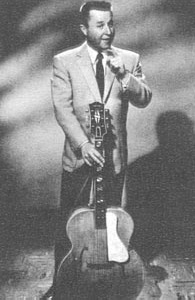 Digression #1: My uncle, Andy Nelson (at left) (1921-1995), was a clinician and salesman for Chicago Musical Instrument Company (CMI), parent of Gibson, Epiphone, and a number of other musical instrument companies. He was also a damned good guitar player–a fact acknowledged by countless fans who still contact me from time to time to share their stories about Andy, who was quite the colorful character. When working for CMI, his main duties were to promote Gibson guitars and accessories by doing clinics and mini-concerts in music stores around the US. It took him two years to make the complete circuit, with he and his second wife (the first of two Muriels) dragging an enormous Airstream trailer behind an International Travelall (similar to a Chevy Suburban). In the early 60s, he was transferred to the Epiphone line (when they were all still made in the US), and did the same types of clinics. He left CMI in 1965 and had a wonderful and lucrative five years with Fender, then a division of CBS, handling sales for New York, New Jersey, and Delaware. In 1970, just as the music industry was going through one of its periodic collapses, he had two heart attacks and was forced to retire at 47 years old. His coronary bypass surgery, still experimental in those days, was only partly successful, but he survived another 25 or so years, popping nitroglycerine pills like they were candy.
Digression #1: My uncle, Andy Nelson (at left) (1921-1995), was a clinician and salesman for Chicago Musical Instrument Company (CMI), parent of Gibson, Epiphone, and a number of other musical instrument companies. He was also a damned good guitar player–a fact acknowledged by countless fans who still contact me from time to time to share their stories about Andy, who was quite the colorful character. When working for CMI, his main duties were to promote Gibson guitars and accessories by doing clinics and mini-concerts in music stores around the US. It took him two years to make the complete circuit, with he and his second wife (the first of two Muriels) dragging an enormous Airstream trailer behind an International Travelall (similar to a Chevy Suburban). In the early 60s, he was transferred to the Epiphone line (when they were all still made in the US), and did the same types of clinics. He left CMI in 1965 and had a wonderful and lucrative five years with Fender, then a division of CBS, handling sales for New York, New Jersey, and Delaware. In 1970, just as the music industry was going through one of its periodic collapses, he had two heart attacks and was forced to retire at 47 years old. His coronary bypass surgery, still experimental in those days, was only partly successful, but he survived another 25 or so years, popping nitroglycerine pills like they were candy.
Digression #2: Andy was also charged with keeping in regular contact with artists and celebrities who used Gibson products. On one of his regular visits to CMI’s headquarters in Chicago, he took some time to look up singer/comedian George Gobel (above right) (1919-1991), who was performing at the famous Empire Room at the Palmer House hotel (see how things come together?).
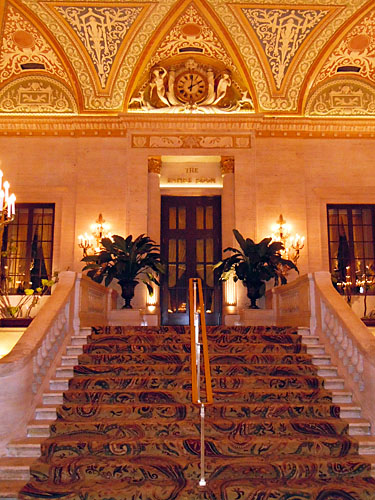
The entrance to the Empire Room — The Palmer House, Chicago
George was, as some would say, “vertically challenged,” standing maybe 5’4″. He played Gibson’s most expensive guitar, the Super 400. Designed to be loud enough to cut through the horn section of a big band (no amplifiers in those days), the Super 400 was a large instrument, 18 inches wide at the lower bout, 3-3/8 inches thick, and a standard scale length (distance from the top “nut” just below the tuning pegs to the bridge) of 25-1/2 inches. It was almost bigger than George! Remember that big f-hole guitar Elvis Presley played (he was dressed in all leather) on his 1968 comeback TV special? That was a Super 400.
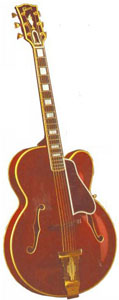
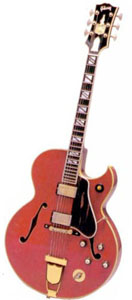 Andy had an idea about a special guitar designed specifically for the diminutive Gobel, and sat down with him at the bar at the Palmer House, and over many drinks, he and George discussed his ideas. Andy proposed using Gibson’s L-5C acoustic archtop model, in production since 1922, trimmed the thickness by an inch, to 2-3/8 inches, shortened the scale length slightly to 24-3/4 inches, wanted to change the top bracing from parallel tone bars to an “X” brace to improve the acoustic sound, and changed the finish to a bright cherry red, to show up better on the new color TVs just coming on the market in 1958. Andy got almost everything he asked for except for the top bracing–mainly because of the extra time and effort it would take Gibson’s Custom Shop to design and build it. The guitar was presented by Gibson President Ted McCarty on the popular Tennessee Ernie Ford Show in late 1958. It was called the L-5CT (L-5 model, cutaway, thin). A second guitar was given to Gobel a few years later after the original one was getting pretty beat-up from being on the road.
Andy had an idea about a special guitar designed specifically for the diminutive Gobel, and sat down with him at the bar at the Palmer House, and over many drinks, he and George discussed his ideas. Andy proposed using Gibson’s L-5C acoustic archtop model, in production since 1922, trimmed the thickness by an inch, to 2-3/8 inches, shortened the scale length slightly to 24-3/4 inches, wanted to change the top bracing from parallel tone bars to an “X” brace to improve the acoustic sound, and changed the finish to a bright cherry red, to show up better on the new color TVs just coming on the market in 1958. Andy got almost everything he asked for except for the top bracing–mainly because of the extra time and effort it would take Gibson’s Custom Shop to design and build it. The guitar was presented by Gibson President Ted McCarty on the popular Tennessee Ernie Ford Show in late 1958. It was called the L-5CT (L-5 model, cutaway, thin). A second guitar was given to Gobel a few years later after the original one was getting pretty beat-up from being on the road.
All in all, Gibson built 43 of these special instruments. But that’s not all. Nearly all of those lucky 43 customers requested further customization from the factory, including adding pickups to play electrically, different finishes (natural or sunburst), at least one natural-finish lefthand model, and Andy personally had six highly customized and ornamented L-5CTs made, which went for the princely sum of $1,500. Andy personally sold every one of those 6 guitars, which he named “The Crest.” This probably made the L-5CT the most customized of all Gibson models, and among the most collectible.
Here’s George Gobel with his Gibson L-5CT Guitar
And we’re back: I arrived at the Palmer House at around 1AM, thanks to the obligatory airline delays. The next morning, after a $22 breakfast (hey, if you have to ask, you can’t afford it), I met up with my cousin Joyce and it was off to the Museum of Science and Industry. We did a whirlwind tour, due to the excessive number of kids, and headed off to the Lincoln Park Zoo, which was a very impressive facility. We then met up with Joyce’s daughter Josie and her family where we spent a nice afternoon reminiscing about family members long passed, who are sorely missed. Then it was dinner time. Josie’s patient husband Chris volunteered to take care of the two year old Jackson while Joyce, Josie, and I went in search of Chicago barbecue. We found some really, really nice barbecue at The Smoke Daddy. We all nearly succumbed from meat poisoning, we ate so much!
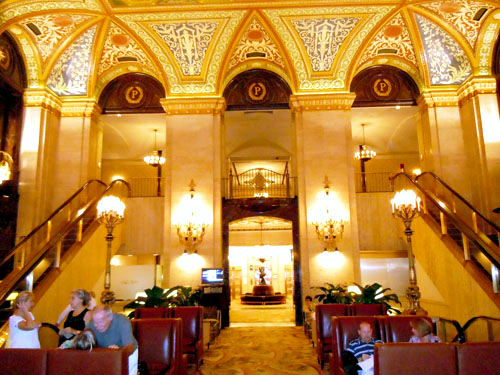
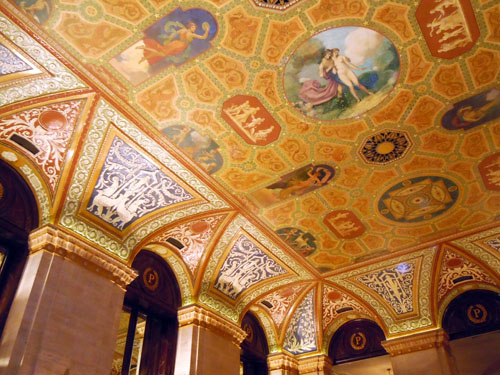
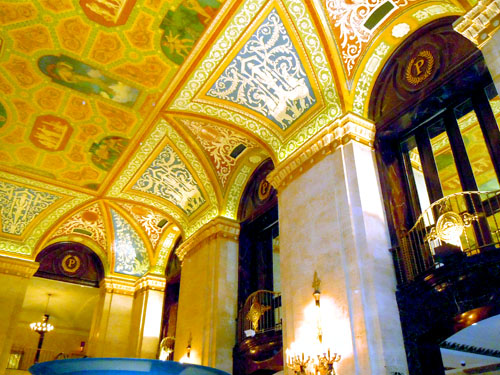
The lobby of the Palmer House Hotel, Chicago
The next day, Joyce and I went to the Art Institute, spending most of our time in the new modern art wing. Very nice, and highly recommended. We walked over to Millennium Park where we checked out the modern sculpture, capped off by a visit to the Bean.” We finished off the day at a nice pub next door to my hotel.

My cousin Joyce and I, up-close and personal with the Bean
The next morning came too early–waaaay too early. I had a 3:15AM wakeup call so I could meet the airport shuttle at 4:15 for a 6:30AM flight. No problems leaving. Everything was on time, and like I had planned, I was back at my desk at work by 10:30. With the heavy work schedule this past week, I made up those hours by Wednesday and didn’t have to take a vacation day.
All in all, a great trip. I hadn’t seen Joyce and Josie in a long time, and hope at sometime we can get some more of the family together and do something even bigger. The older we get, the more we feel the need to connect.

Leave a Reply
You must be logged in to post a comment.